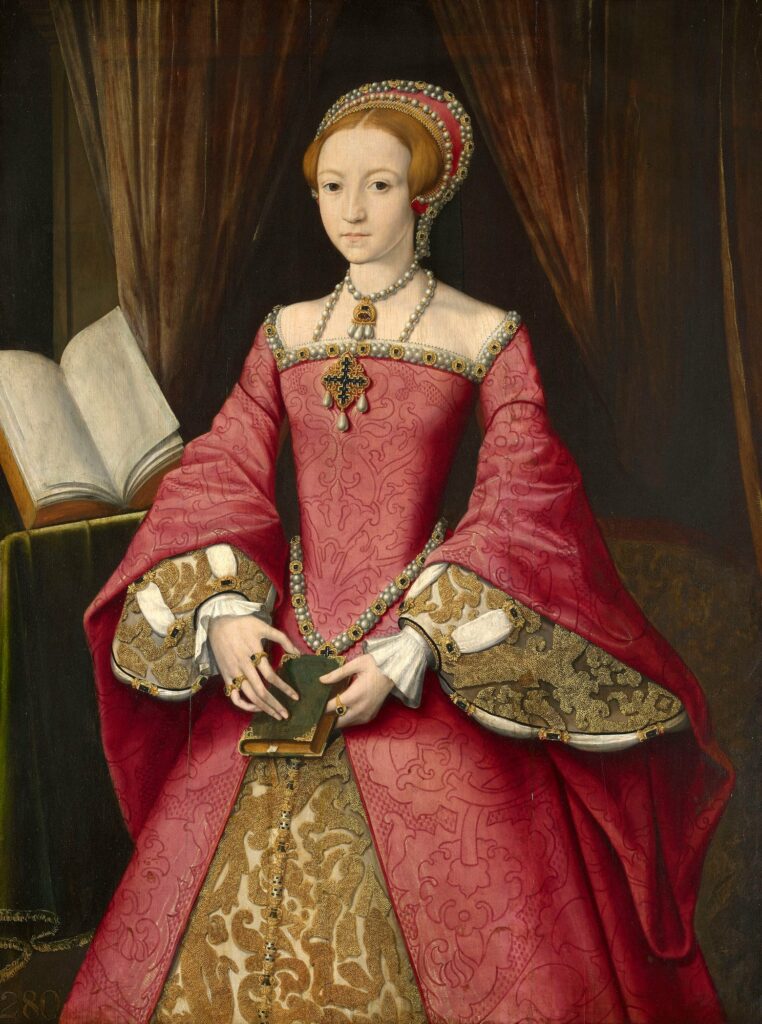
Royal Collection Trust (Queen’s Drawing Room, Windsor Castle), RCIN 404444
This blog is part of series linked to our exhibition, More than Pretty, which looks at body decoration of girls throughout history. Check out the exhibition here.
If I asked you to think of a Tudor girl, you would no doubt think of Elizabeth I or Mary I when they were young. As girls, they may not have been queens, but they were still influential as heirs to the Crown. The ideal Tudor girl would have had light hair, a snow white complexion, red cheeks and lips, and blue, green or grey eyes. Both of our future Queens fit this profile as girls.
Bathing and makeup in Tudor England had not changed much since Medieval times. Several sources reported that Elizabeth used to bathe only once a month, which was more often than the majority of people in England. This is the Myrour or Glasse of Helth was a popular book in the Tudor period that warns against baths or even sweating because that’s how you get sick! Since having a bath was a lot of work, girls would sponge wash daily. They used soap made from olive oil and water scented with herbs like sage, rosemary and camomile to wash parts of the body exposed to the air.
Don’t worry if you don’t have light coloured hair–the Tudors had a few tricks to lighten it up. They had access to henna, but more often used a paste from saffron, cumin seeds, celandine and oil to turn their hair yellow or orange. If you were wealthier you could buy wigs to cover your dark hair. Since it wasn’t common to cut your hair, girls wore theirs loose. Long straight hair was fashionable for girls as it was a sign of youth and virginity. After marriage, hair would be put up in a bun. Having a high forehead was still popular, so hair was brushed back for maximum exposure. As the focus of the face, girls used creams made from ingredients like beeswax, honey and sesame seed oil to keep their skin soft. A flawless complexion was very important. Any blemishes were considered to show the displeasure of God or of sin committed. Girls would cover tanned skin or blemishes with ceruse, a white mixture used like foundation made from vinegar and white lead (which is very toxic!), which was applied over a layer of egg whites (kind of like primer we use today). Having a white complexion was a sign of class because only the wealthy could afford the time and money to properly achieve this. The last touch was to add a little colour with rouge. Rouge was a red powder made from vermilion or cochineal (which is a powder made from beetle-like insects who had a dark red colour).
Eyes and lips finish off the look. Kohl was still being used like mascara is today to darken the eyes. This was imported from the Middle East and cheap enough to be accessible to all. For your lips you could apply lip rouge made from red ochre or a red lipstick made from cochineal, gum arabic and white lead (still poisonous). After knowing that would you wear Tudor lipstick?
Elizabeth I wore this iconic look her whole life, adding more and more make-up to her face as she got older. It was during her reign that cosmetics became a common item for girls and women to own. Many Elizabethan girls would try to be look like their Queen. Perhaps Elizabeth was the first celebrity influencer.
Check back soon for our next blog in this series, Stuart Britain.
-Monique Brough
Curator
Girl Museum Inc.
English Heritage has a cool makeup tutorial on Elizabeth I if you want to see how they did their makeup:
For more information check out
http://www.sixwives.info/tudor-make-up.htm
http://www.mylearning.org/the-painted-lady–tudor-portraits-at-the-ferens/p-2281/
http://timesoftudors.blogspot.co.uk/2013/02/the-ideal-beauty.html
http://onthetudortrail.com/Blog/resources/life-in-tudor-england/tudor-hygiene-part-1-bathing/
https://www.historyextra.com/period/tudor/strange-weird-odd-bad-habits-gross-facts-royalty-royal-family-monarchs-henry-viii-poisoned/
https://timesoftudors.blogspot.com/2013/02/hair-styles.html
